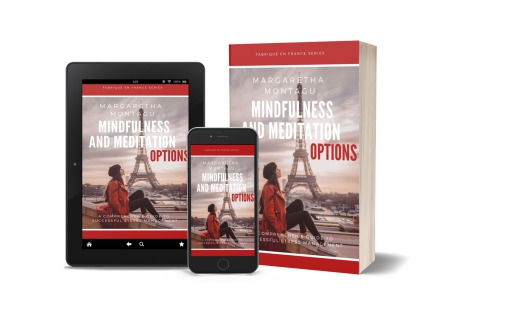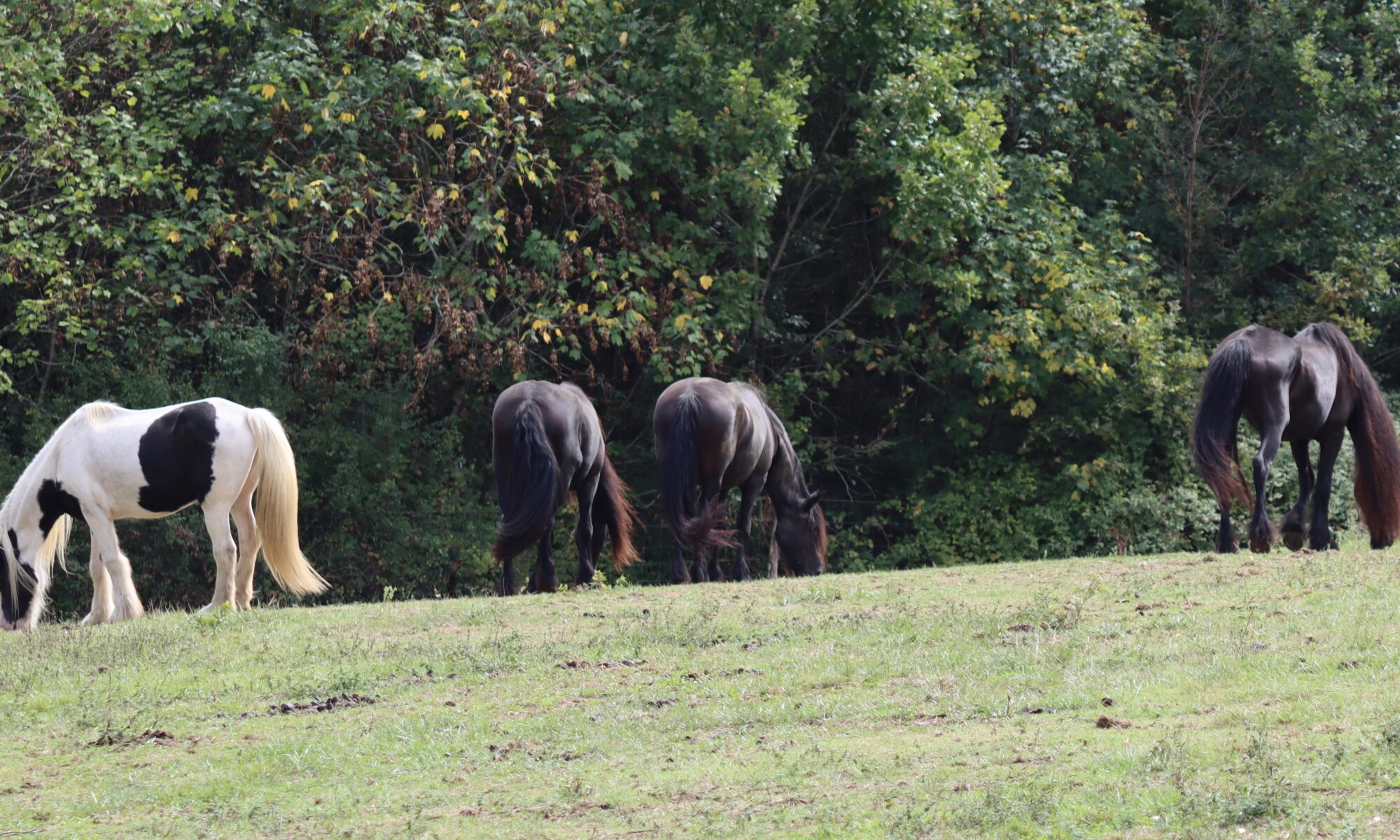.
I. What is Equine-guided Meditation?
That day, everything changed. We were a small group of six, sitting in a circle in the paddock closest to the lake. Belle, Bass, Aurore and Tess grazed peacefully nearby. As I led the loving-kindness meditation, focusing first on each individual, then a loved one, and then the horses, something extraordinary happened. Before I had voiced the second sentence asking participants to send waves of loving-kindness to Belle, our boss mare, she walked over and stood just outside the circle—something she had never done before.
Her presence was intimidating as we sat flat on the ground, and Belle is enormous: 1m65 at the withers. As I started the third sentence, she came over and made clear she intended to enter the circle. I moved slightly to avoid those dinner-plate-sized hooves. Unperturbed, she took her place at the center.
As I moved on to the next phrase, Belle went into equine relaxation mode: licking and chewing, sighing, slowing and deepening her breathing, yawning and lowering her head. She then made the rounds, going to each person in turn—sometimes standing close, sometimes breathing on someone’s hair, sometimes resting her head on theirs. We were so engrossed that we hadn’t noticed the other three horses had approached and were now standing just behind us.
When she had ministered to everyone, Belle left the circle and walked off, the other three following. The group remained so profoundly affected by this experience that it took three days before they came back down to earth. Each person described a deep inner awareness of contentedness and a moving sense of connection and understanding. That day, our equine-facilitated meditation sessions became equine-guided meditation sessions.
Charles de Kunffy sums up the benefits of spending time with horses: “Horses forge the mind, the character, the emotions and inner lives of humans. People can talk to one another about all these things and remain distanced and lonesome. In partnership with a horse, one is seldom lacking for thought, emotion and inspiration.”
I discovered this practice while seeking to improve my relationship with Belle, my soul mare, through Dominique Barbier’s book “Meditation for Two.” Dominique writes: “The only limits I have found have been my own. Where our own egos regularly allow fear and negativity to interfere with our ability to let go and form spiritual connections, horses possess an incalculable ability to function as conduits of connection. Where we analyse, where we try to explain, where we try to re-create, where we try to simply be, horses are already there—waiting for us to walk through the open door.”
Imagine: the soft rustle of hay underfoot, the gentle nicker of a nearby mare, a sun-drenched pasture. You settle onto a cushion, the air carrying the earthy scent of horse and grass. As you draw your attention inward, you notice a quiet, steady presence—a horse, its powerful muscles relaxed, its breath a slow, rhythmic sigh. There’s no judgment in its large, intelligent eyes, only profound stillness that invites you to shed the frantic pace of your inner world and simply be.
This practice is rooted in Equine-Assisted Activities and Therapy (EAA/EAT). For decades, practitioners have harnessed horses’ remarkable capacity to facilitate healing across a spectrum of human challenges—from improving physical coordination and emotional regulation to building self-confidence and processing trauma. The non-judgmental responsiveness of these sentient beings creates a safe space for exploring inner landscapes.
Building upon this foundation, Equine-Guided Meditation (EGM) emerges as a specific practice that consciously integrates horses’ presence, subtle energy, and inherent connection to the present moment to deepen meditative states. It deliberately utilizes horses’ unique qualities—their acute sensory awareness, their mirroring of emotional states, and their profound connection to nature—to guide individuals toward greater mindfulness, inner calm, and self-awareness.
This exploration illuminates the multifaceted world of Equine-Guided Meditation, delving into theoretical underpinnings, practical applications, potential benefits, and crucial considerations for effective and ethical practice. The unique capacity of horses to embody presence, mirror human emotions without judgment, and connect us to the natural world offers a powerful pathway to enhanced mindfulness, stress reduction, and deeper inner peace through intentionally guided meditation.
II. The Theoretical Foundations
A. The Human-Animal Bond (HAB) and Mindfulness
The Human-Animal Bond forms a cornerstone of why Equine-Guided Meditation can be powerfully effective. Research has shown that interacting with animals triggers positive physiological responses: decreased stress hormones like cortisol and increased oxytocin, the “bonding hormone” associated with trust, relaxation, and social connection.
Horses possess remarkable sensitivity to human emotional states, attuned to the slightest shift in our posture, breath, and muscle tension. When we are in their presence during meditation, the horse acts as a living biofeedback mechanism, mirroring our tension or calm without judgment. This non-judgmental presence fosters mindfulness, allowing meditators to approach their internal experience with greater curiosity and gentleness. The horse becomes a silent anchor, reminding us to return to the present moment.
B. Somatic Awareness and Embodiment
Horses’ sheer physical presence—their warmth, scent, and the soft brush of their coat—provides rich sensory input that powerfully grounds individuals in their bodies. Standing beside a horse, you feel subtle vibrations of its breathing, warmth radiating from its flank, and the rhythmic swish of his tail. These tangible sensations draw awareness out of swirling thoughts into grounded reality.
The slow, deliberate gait of a horse during mindful walking can synchronise with our own breath and pace, naturally falling into rhythm. Even when standing still, a horse’s unhurried breathing serves as a gentle metronome, a reminder of a slower, more natural pace. Grooming the horse enhances this embodied experience through tactile sensations, bringing us firmly into the present moment.
C. Mirroring and Emotional Regulation
As prey animals, horses have evolved an exceptional ability to read subtle environmental cues, particularly the emotional states of other beings. This sensitivity extends to humans, making them adept at mirroring our emotions before we’re consciously aware of them. A tightening in the shoulders or shallow breath can be reflected in the horse’s behaviour—a flick of the ear or a change in posture.
This mirroring provides powerful real-time feedback. If anxiety lurks beneath our meditation, the horse might become restless. As we settle into calm, the horse mirrors this with a softened demeanour. This immediate feedback bypasses cognitive defences, revealing what might otherwise remain hidden. The horse’s calm presence also has a co-regulating effect, helping to soothe a dysregulated nervous system.
D. Nature Therapy and the Biophilia Hypothesis
Equine-Guided Meditation often takes place outdoors, immersing participants in nature. The biophilia hypothesis suggests humans have an innate tendency to connect with nature, with significant benefits for physical and psychological well-being. Being in nature reduces stress hormones, improves mood, enhances cognitive function, and fosters peace.
The horse acts as a bridge to the natural world. As a creature deeply connected to nature’s rhythms, the horse embodies groundedness and presence that resonate with the environment. Observing a horse grazing peacefully or sharing space within a pasture amplifies our own connection to the natural world. The outdoor setting provides a multisensory experience that naturally draws attention away from internal distractions, creating synergy between the horse’s calming presence and nature’s restorative power.
E. Energy and Presence
Horses possess a powerful yet grounded energy—a palpable sense of calm strength and unwavering presence. Their strong heartbeat, large muscle mass, and connection to the earth contribute to this significant energetic field. In meditation, this powerful yet stable energy can create stability and grounding, helping anchor scattered thoughts.
The horse’s inherent “being in the moment”—their lack of preoccupation with past or future—radiates powerful presence. This unwavering focus on now can be contagious, drawing meditators away from mental chatter into direct experience of the present. The horse, in its quiet majesty, offers a living lesson in the art of simply being.
III. Practical Applications and Methodologies
A. Setting the Stage: Environment and Horse Selection
The environment contributes significantly to safety, tranquility, and connection. Ideally, the setting should be natural—a gently rolling pasture bordered by trees where the air is fresh and carries subtle nature sounds. Safety is paramount: spaces should be free of hazards, with secure fencing and relatively even ground.
The ideal horse possesses a calm, patient, well-socialised temperament. They should be comfortable with human presence, unfazed by slow movements and stillness. Horses with gentle, curious dispositions and a solid foundation in groundwork are generally more suitable.
The horse handler plays an indispensable role, ensuring the horse’s safety and well-being throughout the session. Skilled handlers possess a deep understanding of equine behaviour and communication, can read subtle cues, and ensure interactions remain respectful and within appropriate boundaries.
B. Different Approaches to Equine-Guided Meditation
Guided Meditation with Horse Presence: Participants engage in traditional guided meditation while in the same physical space as horses. The facilitator guides them through visualisations, breathwork, or mindfulness exercises, encouraging awareness of the horse’s presence as an anchor. The horse’s natural stillness and rhythmic breathing subtly influence participants’ physiological states, serving as gentle reminders to return to the present.
Mindful Observation of the Horse: Participants mindfully observe the horse’s behaviour, movements, and interactions with the environment. The facilitator guides them to notice details—how muscles move as they graze, the subtle flick of ears, the soft blink of eyes. This cultivates present-moment awareness by directing attention outward, with the horse becoming a dynamic focal point.
Gentle Interaction and Embodied Meditation: This integrates mindful interaction—gentle touch, stroking the coat, mindful grooming, or standing quietly in physical contact. Walking alongside the horse at a slow, deliberate pace deepens the embodied aspect by engaging tactile and kinesthetic senses. The warmth and texture of the coat, the feel of breath, the rhythmic sway create tangible links to the present moment.
Movement-Based Meditation: This incorporates slow, mindful movements with or around the horse—gentle leading exercises, mindful walking in circles, or deliberate stretches performed in the horse’s presence. The gentle physical activity helps release pent-up energy and ground the body, while the horse’s presence adds another layer of awareness and connection.
Using the Horse as Metaphor: The qualities and behaviours of horses serve as metaphors for deeper self-reflection. The facilitator might guide participants to consider the horse’s strength and gentleness, acute awareness, or ability to be fully present, then explore how these qualities resonate within their own lives.
C. Facilitator Role and Techniques
The facilitator creates a safe, supportive environment, establishing clear boundaries while fostering trust and openness. They guide participants through visualisations, breathwork, and mindfulness techniques while skillfully weaving the horse’s presence into traditional methods.
Grounding techniques help participants arrive fully in the present moment—body scans, focusing on feet on the ground, or gentle movements. The facilitator offers various anchors for attention, with the horse itself becoming the primary anchor. Adapting meditation to individual needs and comfort levels is crucial, with modifications offered based on experience with both meditation and horses.
D. Integrating EGM with Other Wellness Practices
Equine-Guided Meditation naturally aligns with other mindfulness practices, sharing foundational principles of present moment awareness and inner calm. The natural setting creates synergy with nature-based therapies like forest bathing and horticultural therapy. Traditional therapeutic modalities can be enhanced by incorporating EGM, with the non-judgmental horse presence creating a safe space for exploring difficult emotions.
IV. Benefits and Therapeutic Outcomes
A. Enhanced Mindfulness and Presence
Horses are masters of living in the present moment, deeply attuned to immediate surroundings. This inherent “being in the moment” is palpable and profoundly inspiring. Their unwavering focus invites us to release our grip on past and future and sink into the richness of present experience.
The horse’s exquisite sensitivity to subtle cues encourages heightened self-awareness. Knowing a horse might react to underlying tension prompts us to become more attuned to these internal states—a gentle biofeedback that deepens our capacity for mindfulness.
B. Stress Reduction and Relaxation
Interacting with horses leads to decreased cortisol and increased oxytocin, promoting calm, trust, and well-being. Meditative practices lower heart rate, reduce blood pressure, and decrease sympathetic nervous system activity while increasing parasympathetic activity.
The calm energy of a well-tempered horse has a remarkable co-regulating effect, acting as an external anchor that helps calm a racing mind and soothe anxiety. The sensory environment—fresh air, natural sounds, earthy smells—further contributes to deep relaxation.
C. Emotional Regulation and Grounding
The horse’s mirroring capacity offers a unique pathway to emotional awareness. Their non-judgmental reflection fosters self-awareness, allowing us to see our emotional landscape without filters or self-criticism. This heightened awareness is the first step toward regulation.
The physical presence of the horse and its connection to earth provide powerful grounding. Standing beside a horse or touching its solid body helps ground individuals who feel disconnected or anxious. This grounding effect provides a stable foundation for navigating difficult emotions.
D. Increased Self-Awareness and Intuition
The subtle communication developing between humans and horses enhances self-awareness and fosters a stronger connection to intuition. Learning to read the horse’s subtle cues makes us more aware of our own non-verbal communication and underlying emotions.
The quiet, introspective nature of meditation, combined with the horse’s non-judgmental presence, creates a safe space for exploring our inner landscape. The intuitive nature of horses can awaken our own intuitive abilities, helping us reconnect with inner knowing.
E. Fostering Connection and Empathy
The bond forming between humans and horses cultivates connection, empathy, and compassion. This connection—characterised by trust, mutual respect, and shared being—can foster greater empathy by allowing us to experience the world from a different perspective.
The non-judgmental acceptance felt from horses translates into greater self-compassion. By experiencing unconditional positive regard from these animals, we may extend that same kindness toward ourselves.
F. Potential for Trauma Sensitivity and Healing
(Approach with caution and emphasise trauma-informed facilitation)
For individuals with trauma histories, the non-verbal communication and gentle presence of horses can offer a unique avenue for healing. However, this must only be approached with practitioners deeply trained in trauma-informed care.
Horses respond to energy and body language, reflecting underlying emotional states that may be difficult to articulate verbally. Their consistent, non-judgmental presence creates safety and stability. The physical act of touching or grooming provides safe, grounding sensory experience.
This work requires extreme sensitivity and guidance from dually trained professionals. The facilitator must be attuned to potential triggers, with empowerment and choice paramount. EGM is not a substitute for traditional trauma therapy and should be part of a comprehensive treatment plan.
V. Considerations for Effective and Ethical Practice
A. Horse Welfare and Ethical Interaction
At the heart of ethical EGM lies an unwavering commitment to horse well-being. Horses are not tools but active participants whose comfort and consent are paramount. This necessitates providing appropriate shelter, nutrition, veterinary care, and opportunities for natural behaviour and social interaction.
Ethical interaction demands understanding of equine communication and boundaries. Facilitators and participants must learn to interpret subtle cues—ear position, tail swishing, body tension. Respecting boundaries means avoiding forceful or intrusive interactions, with participants guided to approach calmly and allow horses to initiate or decline contact.
Horses chosen should genuinely enjoy or be comfortable with calm human interaction. Thorough assessment of temperament, patience, tolerance, and disposition is crucial, with regular evaluation of ongoing suitability.
B. Facilitator Training and Competence
Facilitators must possess a robust understanding of both meditation techniques and equine behaviour. Training in meditation should encompass various practices and the ability to guide participants effectively. Crucially, facilitators must have in-depth knowledge of equine ethology, behaviour, and non-verbal communication.
Training must cover identifying and mitigating risks, emergency procedures, and establishing clear safety guidelines. Ongoing professional development is essential, with facilitators staying current with research and engaging in peer supervision.
C. Client Preparation and Informed Consent
Potential participants should receive clear, comprehensive information about what EGM entails, including the integration of mindfulness with horse interactions, potential benefits, and experiences they might encounter. Informed consent is an ongoing process, with participants given ample opportunity to ask questions.
Prior to engagement, assess each participant’s individual needs, prior horse experiences, and comfort levels. Facilitators should adapt activities to accommodate different comfort levels, with direct interaction not always required for a meaningful experience.
D. Safety Protocols and Risk Management
Robust safety protocols are non-negotiable. These include designated safe zones, maintaining appropriate distances, calm demeanour, no sudden movements, supervised interaction, appropriate attire, clear communication, and practised emergency procedures.
The physical environment must be carefully managed with secure fencing, safe ground conditions, removal of obstacles, weather considerations, and adequate space. Facilitators must provide thorough safety briefings, continuous monitoring, and strategic positioning.
E. Cultural Sensitivity and Accessibility
Cultural beliefs significantly shape how individuals perceive and interact with animals. Facilitators must educate themselves about different cultural attitudes toward horses and be sensitive to potential nuances.
Accessibility encompasses addressing barriers related to cost, language, cultural background, and abilities. This includes ensuring physical accessibility, exploring financial options, providing linguistic support, adapting approaches to be culturally sensitive, and considering needs of individuals with disabilities.
VI. Research, Challenges, and Future Directions
A. Current Research Landscape
Existing research in Equine-Assisted Activities and Therapy offers valuable insights, suggesting positive outcomes in areas like reduced anxiety and depression, improved self-esteem, enhanced social skills, and increased emotional regulation. However, there is a clear need for investigation specifically focused on Equine-Guided Meditation mechanisms and efficacy.
B. Challenges in Standardisation and Measurement
One significant challenge is the inherent difficulty of standardisation. The interaction between participant and horse is unique and dynamic, influenced by individual personalities, specific environment, and the facilitator’s approach. Traditional psychological assessment tools may not fully capture the nuanced shifts in embodied awareness and interspecies connection that EGM cultivates.
C. Potential for Wider Integration
The potential for integrating EGM into various settings is considerable. Wellness centres could incorporate EGM for stress reduction and self-awareness. Therapeutic programs could explore EGM as complementary to traditional therapy. Educational initiatives focused on mindfulness and emotional intelligence could benefit from EGM as experiential learning.
D. Future Research Avenues
Key areas for future research include exploring neurobiological effects using EEG or fMRI, comparative studies examining the effectiveness of different approaches, investigating effectiveness for specific populations, longitudinal studies examining long-term effects, and research exploring the horse’s perspective and experience within sessions.
VII. Conclusion
A. The Unique Value of EGM
Equine-Guided Meditation offers a constellation of unique benefits. The horse introduces unparalleled non-judgmental mirroring, providing a tangible reflection of the internal landscape. Horses inherently embody presence and mindfulness, serving as potent anchors for attention.
Interaction cultivates profound embodied awareness, encouraging attunement to physical sensations and fostering mind-body integration. The therapeutic power of the human-animal bond creates safe, supportive space for emotional exploration. Engaging with horses cultivates interconnectedness and empathy.
B. The Importance of Ethical and Mindful Practice
The profound potential of EGM is inextricably linked to an ethical framework. Prioritising horse welfare is fundamental for efficacy and integrity. Ethical facilitation requires a comprehensive understanding of both meditation and equine behaviour, with facilitators acting as ethical guardians.
Mindful practice extends to participants, cultivating respect, patience, and non-interference. Recognising horses as sentient beings with their own experiences is fundamental. Ethical practice demands transparency and informed consent.
C. Concluding Statement
Equine-Guided Meditation reveals a profound avenue for cultivating inner peace, fostering self-awareness, and deepening connection with the natural world. However, realisation of its full potential hinges upon steadfast commitment to ethical practice, with horse well-being paramount.
With a foundation built upon ethical considerations, rigorous training, and reverence for both human and equine spirit, Equine-Guided Meditation stands as a powerful approach to cultivating inner harmony and fostering a profound understanding of ourselves and our interconnectedness with the living world.
VII. Equine-Guided Meditation FAQ
What is equine-guided meditation? Equine-guided meditation combines traditional meditation practices with the presence of horses. Participants meditate in proximity to horses, using the animals’ natural sensitivity and awareness to deepen their own mindfulness practice and connection to the present moment.
Do I need prior horse experience to participate? No prior experience is necessary. Facilitators provide guidance on safe interaction, and the focus is on presence and mindfulness rather than horsemanship skills.
How does the presence of horses enhance meditation? Horses naturally live in the present moment. Their sensitivity to human emotions creates biofeedback that helps participants become more aware of their own mental and emotional states. Their calm presence facilitates deeper meditative states.
What happens during a session? Sessions typically begin with introduction to the horses and safety guidelines, followed by guided meditation exercises in the horses’ presence. Participants may meditate near horses in a pasture, arena, or stable setting, either seated or while quietly walking.
What are the benefits? Benefits include reduced stress and anxiety, increased mindfulness, improved emotional regulation, enhanced mind-body connection, greater self-awareness, and the healing effects of connecting with animals and nature.
Is this suitable for people with anxiety around horses? Yes, with proper guidance. Many participants find that anxiety diminishes as they learn to regulate their breathing and energy. Facilitators provide appropriate support and can adjust distance based on comfort levels.
Where are sessions typically held? Sessions are held at equestrian facilities, therapeutic riding centers, horse sanctuaries, retreat centers, and private farms with appropriate spaces.
What should I wear? Wear comfortable, weather-appropriate clothing and closed-toe shoes. Avoid loose, flowing garments that might flutter and startle horses, and strong perfumes or colognes.
How is this different from equine therapy? While equine-guided meditation focuses primarily on mindfulness practices enhanced by the horse’s presence, equine therapy is a broader therapeutic approach that may include specific psychological interventions and treatment goals.
Can children participate? Yes, children can participate. Programs are typically age-appropriate and may incorporate more movement and guided interaction than adult sessions. Some programs offer family sessions.
IX. Experience Equine-Guided Meditation on the Camino de Santiago
If the practices and principles explored in this article resonate with you, I invite you to experience equine-guided meditation firsthand during one of my Camino de Santiago Crossroads retreats.
These transformative retreats combine the ancient pilgrimage tradition of the Camino with the profound wisdom of horses, offering you the opportunity to walk both an outer path through the stunning landscapes of southwest France and an inner path toward greater self-awareness.
My retreats integrate equine-guided meditation sessions with mindful walking, allowing you to experience the powerful synergy between the contemplative practice of pilgrimage and the gentle presence of horses. Whether you’re seeking clarity at a crossroads in your life, deeper connection with yourself, or simply a meaningful retreat from the everyday, these experiences offer the opportunity for profound transformation.
Learn more about upcoming Camino de Santiago Crossroads retreats
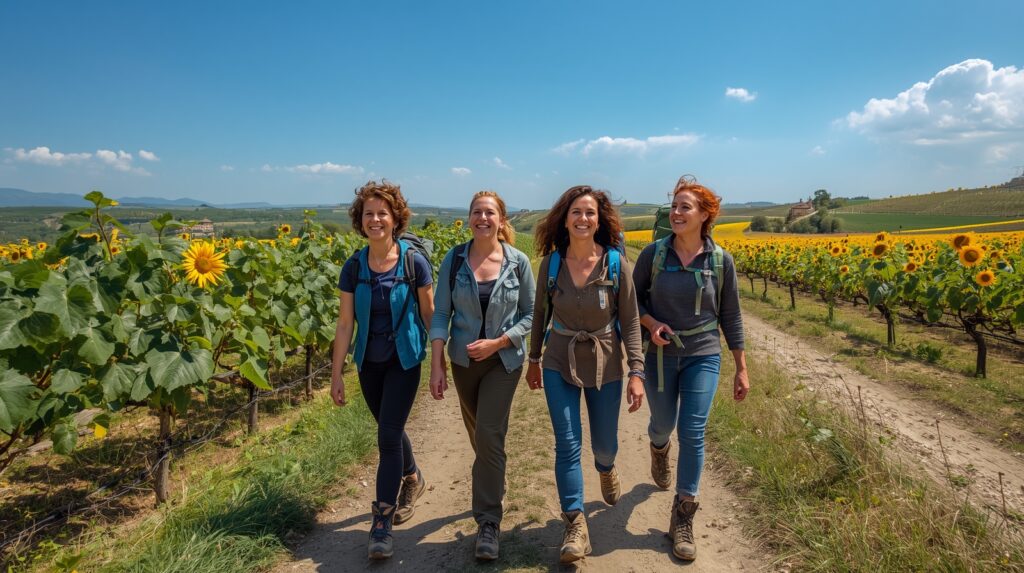


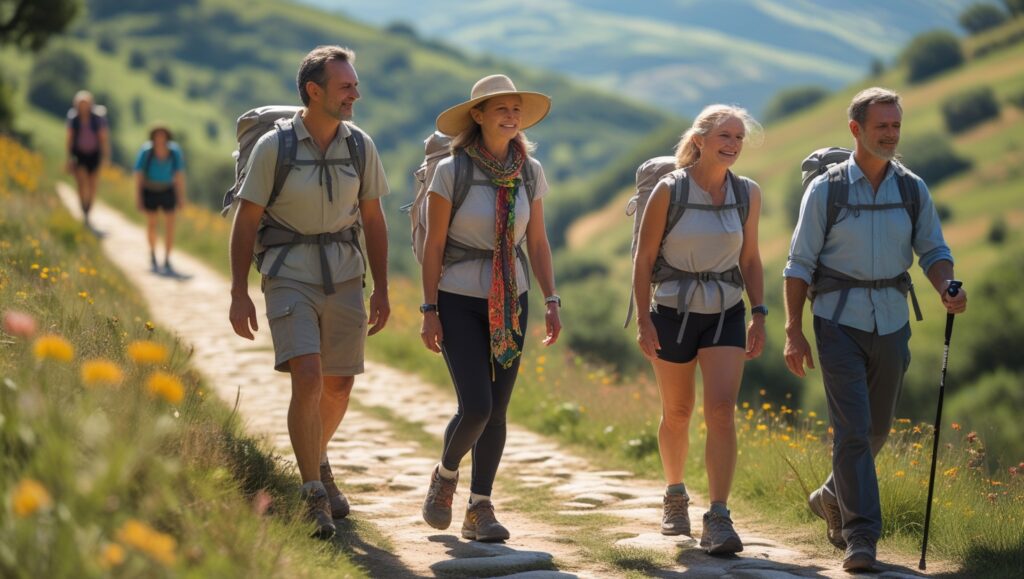






HORSE OWNER’S Retreat: Teach Mindfulness and Meditation with Your Horse(s) – based on equine-facilitated mindfulness and meditation, you’ll discover how to help your friends, family and clients to minimise the detrimental effects of stress , by connecting with your horses in an enriching, compelling, and transformational way (5 or 7 days)
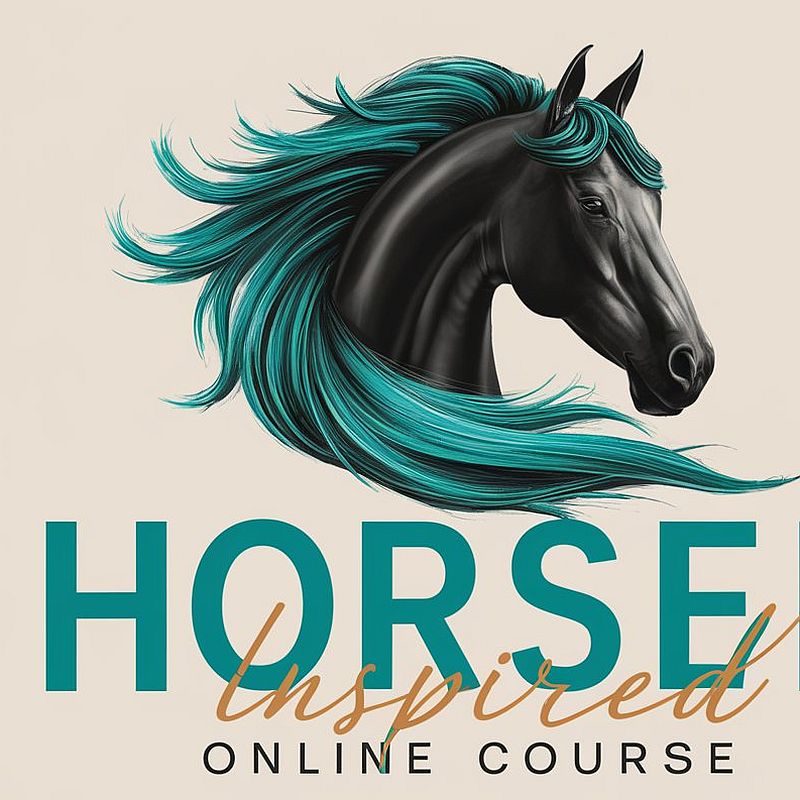
The Harness the Healing Power of Your Horses – Become a Mindfulness Meditation Teacher and Create Substantial and Sustainable Income with Your Horses- an Online Teacher Training and Create a Closer Connection to Your Horse Get immediate access
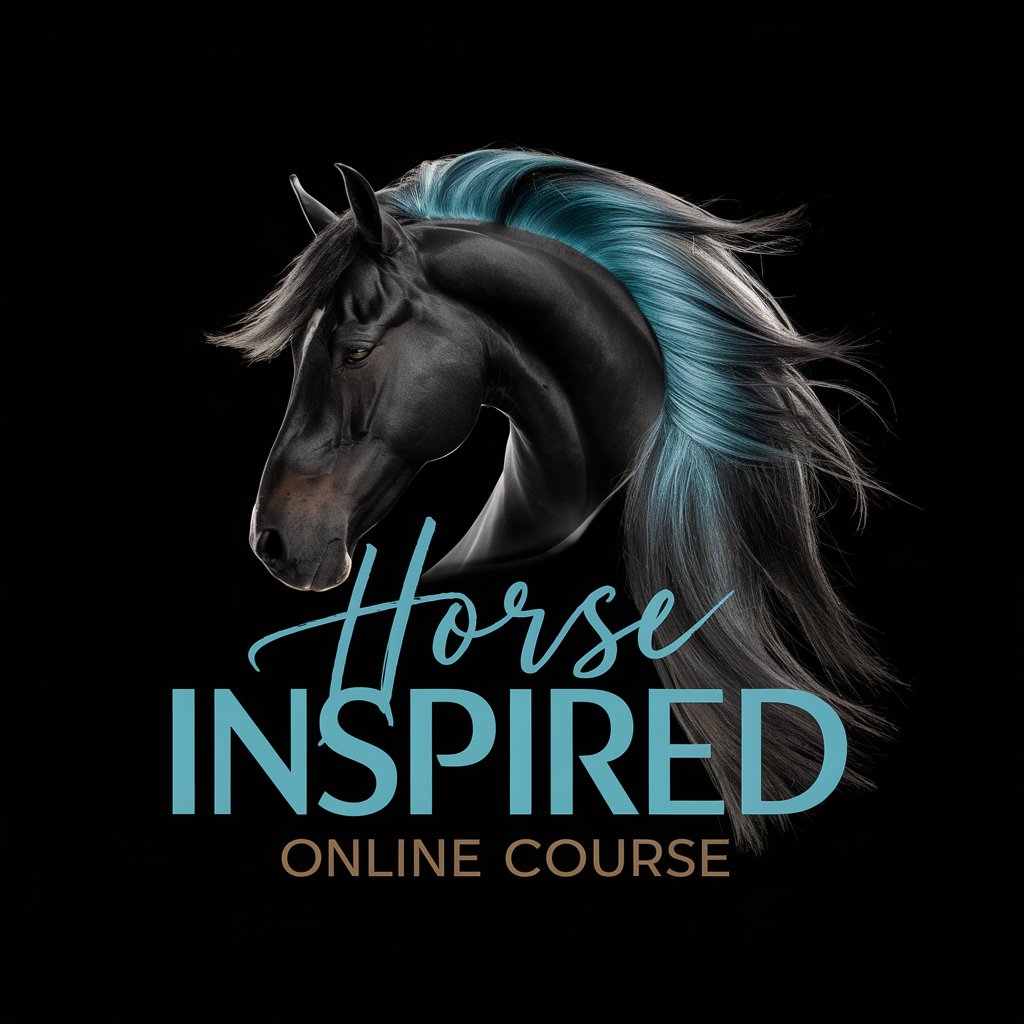
The Compassionate Insight-giving Guide to Getting Over the Loss of Your Horse – an Online Course – find support, guidance, and practical tools to navigate the complex emotions and challenges associated with the loss of a heart horse. Get immediate access
References
- Beetz, A., Uvnäs-Moberg, K., Julius, H., & Kotrschal, K. (2012). Psychophysiological and behavioural effects of human-animal interactions: the possible role of oxytocin. Frontiers in Psychology, 3, 234.
- Kabat-Zinn, J. (1990). Full catastrophe living: Using the wisdom of your body and mind to face stress, pain, and illness. Delta.
- Levine, P. A. (1997). Waking the tiger: Healing trauma. North Atlantic Books.
- Odendaal, J. S. J., & Meintjes, R. A. (2003). Neurophysiological correlates of affiliative behaviour between humans and dogs. Veterinary Journal, 165(3), 296-301.
- Porges, S. W. (2011). The polyvagal theory: Neurophysiological foundations of emotions, attachment, communication, and self-regulation. W. W. Norton & Company.
- Ulrich, R. S., Simons, R. F., Losito, B. D., Fiorito, E., Miles, M. A., & Zelson, M. (1991). Stress recovery during exposure to natural and urban environments. Journal of Environmental Psychology, 11(3), 201-230.
- Wilson, E. O. (1984). Biophilia. Harvard University Press.
